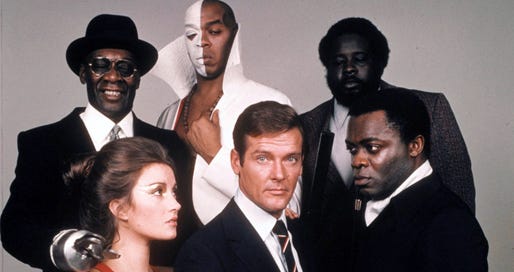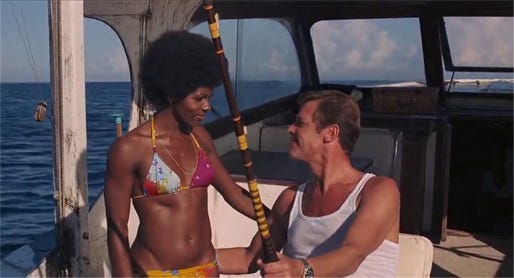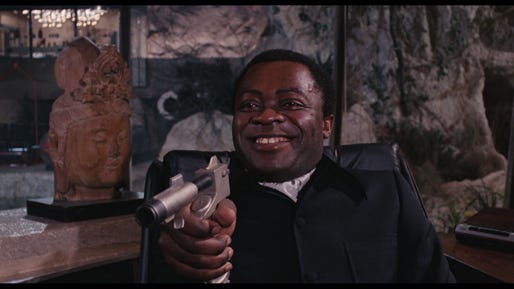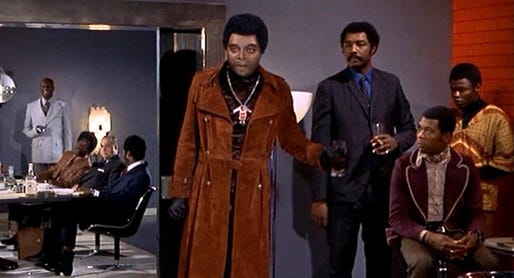You Only Live Twenty-Thrice: "Live and Let Die"
“You Only Live Twenty-Thrice” is a look back at the James Bond films.
Each Friday until the release of the 23rd official Bond film, “Skyfall,” we will revisit its 22 official predecessors from start to finish, with a bonus post for the unofficial films in which James Bond also appears.
Still photos that fix cast members in silly, staged poses are often horrible ways to promote a movie’s mood or momentum. But there is really no more honest sell United Artists could’ve made for 1973’s “Live and Let Die” than the image above.
It finally places Roger Moore front and center as 007 — a role for which the small-screen star was allegedly rumored from the franchise’s conception. At his side is Jane Seymour, barely legal but arguably the most stunningly beautiful lead Bond girl since Ursula Andress. And you may have noticed the four black men menacing Commander Bond — one with a steely death stare, one with a quite literal right hook, one with a painted face and flamboyant collar and one who, well, looks asleep.
James Bond’s lily-whiteness likely never endeared him to most black American moviegoers, but he undoubtedly seemed even squarer in the wake of heroes like Shaft and Super Fly. So throwing Bond into a drug-smuggling plot straight from the blaxploitation playbook simultaneously offered the 007 series its most unique cultural juxtaposition yet and its most potentially offensive. After all, the first predominantly black Bond cast is mostly pushers, pimps and priests of voodoo.
“Live” is sometimes hilariously outdated, but it feels neither like pandering to a black audience nor an inappropriate insult with racist caricatures. There are some wincing bits, though. One black cabbie who amusingly calls James Bond “Jim” later makes an uncomfortable reference to “a KKK cookout,” and a light dusting of backwoods Sheriff J.W. Pepper (Clifton James) goes a long way.
But just as Bond fought assassins Mr. Kidd and Mr. Wint in “Diamonds Are Forever” because they were evil and not because they were homosexuals, Bond doesn’t sleep with a black woman because she’s black. It’s because Gloria Hendry is a knockout, even if her performance as the duplicitous double agent Rosie Carver is patently terrible.
All of the afros, Caddies and talk of the heroin trade feel like fashions, functions and fictional interests of the era. (For tackling the same drug subject two years earlier, “The French Connection” won multiple Oscars.) And “Live” became the Bond series’ highest-grossing entry to date — nearly doubling the cash brought in the last time there was a switch from Sean Connery.
Like the also-reasonably entertaining “Quantum of Solace,” it also rarely feels like a movie with James Bond at its center, which makes it a somewhat strange choice as Moore’s introduction to the series. Save the gadget wristwatch, almost anyone could’ve been the hero in this hybrid of blaxploitation grit and bayou-bumpkin adventure. Paul Newman, perhaps. Maybe Clint Eastwood? Or how about Robert Redford? After “Deliverance,” this would be a swim in the swamp for Burt Reynolds.
United Artists is said to have considered them all once Connery departed after soaking the studio for a one-and-done in “Diamonds.” But producers Albert R. “Cubby” Broccoli and Harry Saltzman insisted that Bond be played by an Englishman. And after a decade of flirting with the role, Moore finally became available.
Albeit as an extra, Moore’s first movie role came 30 years before his debut as Bond. Following a failed contractual stint with MGM Pictures in the 1950s, Moore found his niche on TV, where he found his own ticket to international fame as another beloved British action hero. Over 118 episodes and six seasons, Moore played Simon Templar in “The Saint” — one of Britain’s longest-running adventure series and a stateside hit after NBC picked it up in 1966.
When George Lazenby stepped in for Connery in 1968, Moore was still headlining “The Saint.” And when it came time to cast “Diamonds” in 1971, Moore was then highest-paid actor on TV in a new series — the short-lived “The Persuaders!” with Tony Curtis. But the time was right for Moore in 1972 … even if he was 45 years old.
Connery and Lazenby were about 15 years younger than that when they started. Plus, Moore resented demands to shed hair and pounds, and suffered kidney stones before filming even commenced. Obstacles aside, Moore appears far fitter to play Bond than the paunchy 40-year-old Connery in “Diamonds.” In fact, he’s three years older than Connery but looks at least three years younger.
In some instances, Moore appears practically boyish. And at other times, he resembles a well-coiffed and –tailored brother to David Bowie. He barely buttons his billowing, open-collared shirts — all the better to show off his remarkably fit physique — and he makes a stogie as essential an accessory as his cufflinks. And even though he’s just an inch shorter than Connery and Lazenby, Moore feels smaller somehow, less deadly or threatening than either of his predecessors.
In a “Live” moment when Bond tells Rosie he’ll kill her if she doesn’t spill the beans, Moore sounds as if he’s play-acting. His hand-to-hand combat feels far more telegraphed and less thunderous. Although he never emasculates Bond, he’s clearly more comfortable throwing winks than fists.
Apropos, then, that Moore’s Bond is introduced not in a whiz-bang action sequence but in a post-coital glow at his mansion. He’s rousted there in the early morning by M (Bernard Lee) to look into the deaths of three agents investigating Kananga (Yaphet Kotto) — the dictator of San Monique, a fictional Caribbean country.
One is killed through some sort of brain-melting audio assassination at the United Nations. Another is bitten by a snake during a voodoo ceremony in the Caribbean jungle. And the third is disposed of, and disappeared, with the help of a jazz funeral in New Orleans’ French Quarter.
It’s followed by an opening-credit sequence that, for the first time in a Bond film, feels like a scary horror show. Wide-eyed faces flash to flaming skulls and back again over the driving of the first rock ‘n’ roll Bond theme — Paul McCartney and Wings’ “Live and Let Die,” which ends on a long, ominous note.
Not bad for a guy from a band Bond hated, huh? A Top 40 hit, an Oscar nominee and one of the five best Bond themes of all time, McCartney’s song cost so much that high-profile composers (like longtime Bond collaborator John Barry) were unavailable to write the score. Thus, Beatles producer George Martin was tapped to score the film — a true disco-string blaxploitation job with flurries of flutes and blasts of brass.
It’s an awkward aural shift, but it fits the fixes in which Bond finds himself here — from Harlem alleys to Louisiana lakes. Bond’s Caucasian complexion has also never been so readily apparent, and “Live” forces him to adapt to a trio of foreign locales in which he’s easily spotted and, thus, more susceptible.
After surviving several attempts on his life in Harlem, Bond discovers a link between Kananga and Mr. Big, an American drug dealer who looks curiously like a burn victim.
This Harlem kingpin and the Caribbean dictator share more than a business plan. They share DNA, as they are one and the same. Kananga keeps his poppy fields undetected by exploiting the San Monique people’s fear of voodoo and employing the towering, “unkillable” voodoo priest Baron Samedi (Geoffrey Holder), whose laugh feels like a character all of its own).
Kananga then smuggles the crops to New Orleans, where dilapidated shacks hide high-tech heroin labs. And as “Mr. Big,” he’ll flood the market with free heroin — a “welfare system for junkies” to get them hooked on his product and squeeze out all cartels.
Not a boring plot, but it could be easily Bond-ified: Why not have Kananga’s heroin be somehow cursed by voodoo to hook everyday average people on drugs and cripple America’s economy? Is that really less preposterous than Blofeld’s attempt to bacterially blight the food supply in “On Her Majesty’s Secret Service”? At least it would give Kotto more villainous megalomania to complement his blaxploitation aptitude; Kotto is sinister in the role, but there’s little memorable about him save the best death yet for a Bond villain.
And that amendment to Kananga’s plot would also be no more ridiculous than what happens to the secret of his success — which hinges on the soothsaying skills of Solitaire (Seymour), a beautiful woman born into his evil empire.
Solitaire’s fortune-telling powers disappear after her participation in, uh, “physical love” with Bond, who stacks her tarot deck with cards suggesting they’re destined to be lovers and seduces her for information.
For once, a Bond movie explicitly attaches supernatural powers to Bond’s penis, and this plot development similarly robs Seymour — one of few Bond girls with a legitimate, award-winning career — of sufficient opportunities to be anything more than an extremely pretty face. She does instigate a good fakeout on a tarmac, though. And she at least gets a terrifically suspenseful scene in which Solitaire, powers depleted after her deflowering, must demonstrate second sight while the hook-handed Tee Hee (Julius Harris) threatens Bond’s manhood.
“Live” also leaves Solitaire out of action scenes, which lack the scope and thunder of vintage Connery while improving on the sluggish “Diamonds.” They also mostly eschew glitzy, glamorous locales for murky, rural backwater battles. Those are real crocodiles this stuntman is running on … and they’re not the most cooperative.
And then there’s the film’s astounding centerpiece boat chase — an impeccably pieced-together 10-minute sequence. Most of that, thankfully, is taken up by the stunning work of director Guy Hamilton’s second-unit crew and the three-man editing crew, which maximizes speed, subtle humor and excitement as the chase winds around swampy waters and even onto land.
However, its natural flavor is overwhelmed by the addition of too much Pepper, the yahoo forefather to yokel lawmen like Buford T. Justice and Roscoe P. Coltrane who feels imported from another movie altogether. (James is still kicking at 91, and you’d never know it from this, his bit in “The Man with the Golden Gun” or a similar part in “Superman II,” but he’s a native New Yorker.)
In the longest tenure for any Bond actor, Moore would have higher highs (“The Spy Who Loved Me”) and lower lows (“Moonraker”). And even while “Live and Let Die” strays from the Bond feeling in ways good and bad, it’s a fine introduction to a 007 more prone to crack wise than crack heads.
Next week: "The Man with the Golden Gun"
BULLET POINTS
According to Roger Moore’s DVD commentary track, producers paid a “protection fee” to a local Harlem gang for ensuring the crew’s safety. When that cash ran out, the production was subtly nudged, as it were, to leave town.
Because of prohibited apartheid laws in South Africa, Gloria Hendry’s love scenes with Moore were excised from the film upon its original release there.
Seventeen of the 26 boats built for the bayou chase were destroyed … during rehearsals. And the stunt team wasn’t much more careful with the nine left for filming. After clearing 110 feet in one of the bayou jumps, one speedboat driver unintentionally set a Guinness World Record.
From the time Desmond Llewellyn was introduced in “From Russia with Love” to his death in 1999, “Live and Let Die” is the only James Bond film in which his Q doesn’t appear. Llewellyn was working on the TV series “Follyfoot” at the time and had even been written out of three episodes so he could appear in the film. However, producers decided to forego Llewellyn’s appearance in favor of Clifton James as Sheriff J.W. Pepper. It’s a bizarre omission. M and Moneypenny are here? Why not Q?
There’s a nice reference to the first-ever Bond film with a character played by actor Roy Stewart. As Quarrel Jr., he’s Bond’s eyes and ears in the Caribbeaan. If that name sounds familiar, it’s implied that he’s the son of Quarrel from “Dr. No.” At least Quarrel Jr. doesn’t stand screaming while waiting for a slow-moving, fire-shooting tank to take him out.






